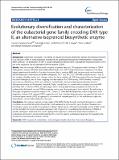Por favor, use este identificador para citar o enlazar a este item:
http://hdl.handle.net/10261/83233COMPARTIR / EXPORTAR:
 SHARE
BASE SHARE
BASE
|
|
| Visualizar otros formatos: MARC | Dublin Core | RDF | ORE | MODS | METS | DIDL | DATACITE | |

| Título: | Evolutionary diversification and characterization of the eubacterial gene family encoding DXR type II, an alternative isoprenoid biosynthetic enzyme |
Autor: | Carretero-Paulet, Lorenzo CSIC ORCID CVN; Lipska, Agnieszka; Pérez-Gil, Jordi CSIC ORCID; Sangari, Félix J. CSIC ORCID; Albert, Víctor A.; Rodriguez-Concepcion, Manuel CSIC ORCID | Fecha de publicación: | 3-sep-2013 | Editor: | BioMed Central | Citación: | BMC Evolutionary Biology 13(1) : 180- (2013) | Resumen: | Abstract Background Isoprenoids constitute a vast family of natural compounds performing diverse and essential functions in all domains of life. In most eubacteria, isoprenoids are synthesized through the methylerythritol 4-phosphate (MEP) pathway. The production of MEP is usually catalyzed by deoxyxylulose 5-phosphate reductoisomerase (DXR-I) but a few organisms use an alternative DXR-like enzyme (DXR-II). Results Searches through 1498 bacterial complete proteomes detected 130 sequences with similarity to DXR-II. Phylogenetic analysis identified three well-resolved clades: the DXR-II family (clustering 53 sequences including eleven experimentally verified as functional enzymes able to produce MEP), and two previously uncharacterized NAD(P)-dependent oxidoreductase families (designated DLO1 and DLO2 for DXR-II-like oxidoreductases 1 and 2). Our analyses identified amino acid changes critical for the acquisition of DXR-II biochemical function through type-I functional divergence, two of them mapping onto key residues for DXR-II activity. DXR-II showed a markedly discontinuous distribution, which was verified at several levels: taxonomic (being predominantly found in Alphaproteobacteria and Firmicutes), metabolic (being mostly found in bacteria with complete functional MEP pathways with or without DXR-I), and phenotypic (as no biological/phenotypic property was found to be preferentially distributed among DXR-II-containing strains, apart from pathogenicity in animals). By performing a thorough comparative sequence analysis of GC content, 3:1 dinucleotide frequencies, codon usage and codon adaptation indexes (CAI) between DXR-II sequences and their corresponding genomes, we examined the role of horizontal gene transfer (HGT), as opposed to an scenario of massive gene loss, in the evolutionary origin and diversification of the DXR-II subfamily in bacteria. Conclusions Our analyses support a single origin of the DXR-II family through functional divergence, in which constitutes an exceptional model of acquisition and maintenance of redundant gene functions between non-homologous genes as a result of convergent evolution. Subsequently, although old episodic events of HGT could not be excluded, the results supported a prevalent role of gene loss in explaining the distribution of DXR-II in specific pathogenic eubacteria. Our results highlight the importance of the functional characterization of evolutionary shortcuts in isoprenoid biosynthesis for screening specific antibacterial drugs and for regulating the production of isoprenoids of human interest. | URI: | http://hdl.handle.net/10261/83233 | Identificadores: | http://dx.doi.org/10.1186/1471-2148-13-180 |
| Aparece en las colecciones: | (IBBTEC) Artículos (IBMCP) Artículos (CRAG) Artículos |
Ficheros en este ítem:
| Fichero | Descripción | Tamaño | Formato | |
|---|---|---|---|---|
| 1471-2148-13-180.xml | 165,93 kB | XML | Visualizar/Abrir | |
| 1471-2148-13-180-S1.PDF | 677 kB | Adobe PDF |  Visualizar/Abrir | |
| 1471-2148-13-180-S2.PDF | 17,08 kB | Adobe PDF |  Visualizar/Abrir | |
| 1471-2148-13-180-S7.PDF | 2,22 MB | Adobe PDF |  Visualizar/Abrir | |
| 1471-2148-13-180-S3.PDF | 17,07 kB | Adobe PDF |  Visualizar/Abrir | |
| 1471-2148-13-180-S5.PDF | 150,65 kB | Adobe PDF |  Visualizar/Abrir | |
| 1471-2148-13-180-S4.PDF | 17,4 kB | Adobe PDF |  Visualizar/Abrir | |
| 1471-2148-13-180-S8.PDF | 92,02 kB | Adobe PDF |  Visualizar/Abrir | |
| 1471-2148-13-180.pdf | 2,03 MB | Adobe PDF |  Visualizar/Abrir | |
| 1471-2148-13-180-S6.XLS | 1,04 MB | Microsoft Excel | Visualizar/Abrir |
CORE Recommender
Page view(s)
338
checked on 18-abr-2024
Download(s)
1.405
checked on 18-abr-2024
Google ScholarTM
Check
NOTA: Los ítems de Digital.CSIC están protegidos por copyright, con todos los derechos reservados, a menos que se indique lo contrario.
